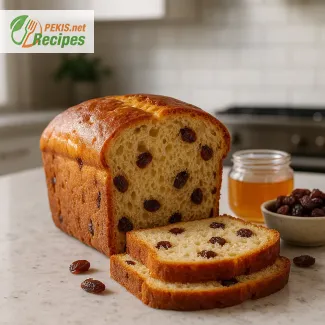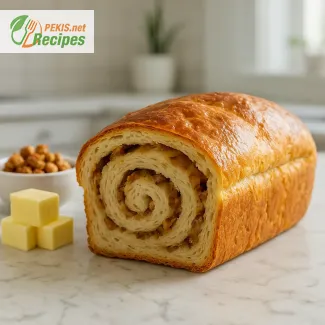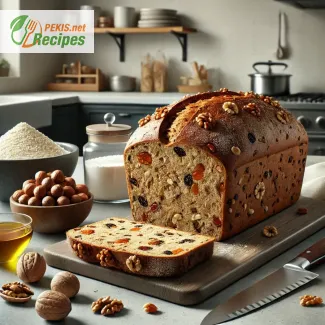
Irresistibly Fluffy Brioche: The Ultimate Buttery Bread Experience
Discover the rich taste and tender texture of homemade brioche that melts in your mouth
Few things rival the pleasure of slicing into a loaf of soft brioche bread, warm from the oven, its golden crust giving way to a pillowy, buttery interior. This luxurious French-style bread has become a beloved staple in both sweet and savory creations, known for its tender crumb, subtle sweetness, and indulgent richness. Crafted with simple ingredients and patience, homemade brioche elevates everyday baking into something truly extraordinary.
The beauty of this fluffy brioche bread lies in its texture: a delicate balance between lightness and decadence. Its tender, almost cake-like crumb is achieved through a high butter content, enriched dough, and slow fermentation process that allows the gluten to develop while deepening the flavor. The result is a bread that's not only incredibly satisfying on its own, but also versatile enough to use for French toast, sandwiches, bread pudding, or simply slathered with a touch of jam.
Making brioche from scratch might seem intimidating at first, especially with its extended kneading time and multiple proofing stages, but the process is deeply rewarding. Once you've experienced the transformation of dough from sticky and elastic to silky and resilient, you'll understand why so many bakers fall in love with this bread. A stand mixer is helpful, but not essential—kneading by hand is possible with a bit of patience and care.
The magic of enriched doughs
Brioche dough is an enriched dough, meaning it's made with ingredients that add fat and moisture, such as butter, eggs, and milk. These ingredients not only make the bread rich and flavorful but also contribute to its signature soft, fluffy crumb. Unlike lean doughs used in baguettes or ciabatta, enriched doughs are more tender and less chewy, making them ideal for indulgent loaves like this one.
While the classic recipe calls for a generous amount of butter—often added gradually during mixing to ensure it’s properly emulsified into the dough—modern adaptations sometimes reduce the quantity slightly without sacrificing the characteristic richness. The key is using high-quality butter and giving the dough plenty of time to rise. A long, cold ferment in the fridge overnight helps the dough firm up and become easier to shape, while also enhancing its complex flavor.
Golden crust, buttery flavor, melt-in-your-mouth crumb
One of the distinguishing features of brioche bread is its appearance. When baked properly, the loaf develops a beautiful golden-brown crust with a slight sheen, often brushed with an egg wash before going into the oven. The crust is thin and tender, contrasting beautifully with the airy interior. Inside, the crumb should pull apart in soft, delicate strands, slightly sweet and full of buttery richness.
This bread is often shaped in a traditional braided loaf or baked in a simple pan for a uniform, sliceable version. Whether you prefer a classic domed top or the elegance of three distinct rolls baked together, the flavor remains the same—decadent, rich, and endlessly satisfying.
A French classic with global appeal
Though brioche has its roots in French culinary tradition, its appeal stretches far beyond France. Around the world, bakers and home cooks embrace this dough for its adaptability and luxurious texture. It can be transformed into brioche burger buns, breakfast rolls, twisted cinnamon loaves, or even festive holiday braids. Its ability to pair with both sweet and savory flavors makes it a kitchen essential for those who love baking.
Fresh out of the oven, brioche fills the kitchen with the warm, buttery aroma that hints at its flavor. Once cooled, it keeps well for several days when wrapped tightly, and it can be frozen for longer storage. Toasting a slice of brioche revives its softness and enhances its sweet, nutty flavor, making it an ideal canvas for spreads, cheese, or even a poached egg.
Why make brioche at home?
There’s something deeply satisfying about making your own brioche loaf. The process teaches patience and care, while the result is far more rewarding than anything store-bought. Homemade brioche allows you to control the quality of your ingredients, customize the sweetness or richness to your taste, and experience the magic of dough that rises, transforms, and becomes something extraordinary.
Kneading the dough until it’s perfectly smooth and elastic, watching it rise slowly in the fridge, then shaping it into its final form—each step is part of a ritual that connects you to centuries of baking tradition. And when you pull that soft, golden loaf from the oven, the reward is immediate: a slice of bread that’s airy yet satisfying, rich yet balanced, and comforting in every bite.
In the next step, we’ll guide you through the detailed recipe for the perfect soft brioche bread—from ingredients and measurements to shaping, proofing, and baking for the ideal loaf every time.
- Activate the yeast:
Warm the milk (not hot, about 37–40°C / 98–104°F) and dissolve the sugar in it. Sprinkle the instant yeast over the milk, stir lightly, and let sit for 10 minutes until frothy. - Make the dough:
In a large mixing bowl (or stand mixer with dough hook), combine flour and salt. Add the yeast mixture and beaten eggs. Knead for 5–6 minutes until a rough dough forms. - Incorporate the butter:
Gradually add the softened butter, one tablespoon at a time, kneading thoroughly after each addition. Continue kneading for about 10–15 minutes until the dough becomes smooth, glossy, and elastic. - First proofing:
Shape the dough into a ball, place it in a lightly greased bowl, and cover with plastic wrap or a clean towel. Let it rise in a warm place for about 90 minutes, or until doubled in size. - Chill the dough:
After the first rise, punch down the dough and refrigerate it for 1 hour. This step firms up the dough, making it easier to shape. - Shape the brioche:
Remove the chilled dough and divide it into 3 equal portions. Roll each into a log and braid them gently. Place the braid in a greased 9x5 inch (23x13 cm) loaf pan. - Second proofing:
Cover the loaf and let it rise for another 60–75 minutes at room temperature until puffy and nearly doubled in size. - Prepare egg wash and bake:
Preheat the oven to 180°C (350°F). Beat the egg with water and gently brush the loaf. Bake on the middle rack for 25–30 minutes or until deep golden brown and a skewer comes out clean. - Cool and serve:
Let the brioche cool in the pan for 10 minutes, then transfer to a wire rack to cool completely before slicing.
Mastering Brioche: Tips and Creative Variations to Perfect Your Loaf
Explore techniques and ingredient upgrades that elevate your homemade brioche
Brioche is already one of the most indulgent and satisfying breads you can bake, but there are several ways to enhance its flavor, texture, and health profile while keeping the essence of this traditional French loaf intact. Whether you're an experienced baker or making your first loaf, understanding how small changes affect the outcome can help you craft the perfect slice every time. This guide dives into creative adaptations, common baking mistakes, ingredient upgrades, and healthier alternatives that can help you improve your brioche bread recipe.
Use higher-quality fats for better flavor
The richness of brioche depends heavily on the quality of butter used. While standard unsalted butter works well, European-style butter with a higher fat content (around 82%) imparts a more pronounced flavor and contributes to a softer crumb. For a twist, consider infusing the butter with herbs like rosemary or orange zest before incorporating it into the dough. This small step adds a subtle depth that enhances the final taste.
Alternatively, you can experiment with brown butter, which adds nutty, caramelized notes that pair beautifully with the slight sweetness of brioche. Simply cook the butter until golden and aromatic, then cool it before using.
Adjust sweetness based on usage
Traditional brioche sits on the sweet side of the bread spectrum, but the amount of sugar can be tweaked depending on the intended use. If you're planning to use the bread for savory sandwiches, reduce the sugar to 30 g (2 tbsp) or less to create a more neutral profile. On the other hand, if you're baking brioche for desserts or French toast, a slight increase in sugar—up to 80 g (⅓ cup)—will highlight its sweet, buttery character.
You can also explore alternative sweeteners. Honey or maple syrup not only sweeten the dough but also introduce subtle floral or woody undertones that elevate the overall flavor complexity.
Enrich with dairy for an even softer crumb
Brioche already contains milk, but adding a small amount of heavy cream or substituting part of the milk with buttermilk can lead to a more tender, velvety texture. Buttermilk also brings a slight tang that balances the richness of the butter, creating a more nuanced flavor. Be mindful to adjust the flour slightly to compensate for the added liquid content.
Use alternative flours for texture and nutrition
While all-purpose flour gives brioche its classic soft crumb, experimenting with different types of flour can yield unique textures and health benefits. Incorporating up to 20% whole wheat flour adds a nutty note and increases fiber content without sacrificing softness. For a more rustic feel, a touch of spelt flour can bring earthiness and a slightly drier bite, which pairs well with savory additions like cheese or herbs.
Gluten-free versions can be achieved with pre-mixed gluten-free flour blends that contain xanthan gum or psyllium husk for elasticity. However, these versions require precise hydration and proofing to maintain lightness.
Add inclusions for flavor variation
Once you're comfortable with the base dough, try adding ingredients that transform the flavor profile. Some ideas include:
- Dark chocolate chips or chopped couverture for a dessert-style loaf
- Dried fruits such as cranberries, apricots, or raisins for a festive touch
- Toasted nuts like almonds, pistachios, or pecans for added crunch
- Savory elements like grated cheese, caramelized onions, or chopped olives for a bold twist
These inclusions should be folded into the dough after the first proofing, just before shaping.
Improve structure with autolyse and long fermentation
A simple technique to enhance the structure and chew of your brioche is the autolyse method, which involves mixing just the flour and milk, then resting for 20–30 minutes before adding other ingredients. This hydrates the flour, improving gluten development with less kneading.
Additionally, refrigerating the dough overnight (cold fermentation) deepens the flavor and makes the dough easier to shape. The slower rise also leads to better oven spring and a more uniform crumb.
Avoid common mistakes
Even experienced bakers can stumble when working with enriched doughs. Here are some pitfalls to avoid:
- Adding butter too early: Mix the dough until gluten is developed before incorporating butter to prevent greasiness.
- Overproofing: If the dough over-rises, it can collapse during baking and develop a coarse crumb. Stick to the proofing times and use the “finger dent” test to check readiness.
- Overflouring during kneading: Excess flour during kneading can lead to a dense loaf. Grease your hands or use a dough scraper instead.
- Underbaking: A deep golden crust is essential. Underbaked brioche will collapse and remain gummy inside.
Create healthier alternatives
While traditional brioche is indulgent, you can adjust ingredients to suit dietary preferences:
- Reduce butter by 25% and replace with unsweetened applesauce for moisture with fewer calories.
- Replace sugar with a natural sweetener like erythritol or coconut sugar for lower glycemic impact.
- Use plant-based butter and milk for a dairy-free version.
- Incorporate flax eggs (1 tbsp ground flaxseed + 3 tbsp water per egg) for a vegan alternative.
Each substitution slightly affects texture and rise, so expect a denser crumb, but the flavor can remain satisfying.
Customize shaping and baking styles
The classic braided loaf isn’t the only option. Use your brioche dough to create:
- Mini rolls: Bake in muffin tins for individual servings
- Pull-apart bread: Shape into balls and layer in a loaf pan
- Twist breads: Roll out dough, spread with cinnamon or jam, then twist into wreaths or knots
- Brioche à tête: Traditional French rolls baked in fluted molds
Each format offers a different experience—from elegant table centerpieces to lunchbox-ready snacks.
Homemade always means fresher and better
The store-bought versions of brioche often contain preservatives, emulsifiers, and lower-quality fats to extend shelf life. By making brioche at home, you ensure every ingredient is fresh and customizable, and the result is bread that’s softer, more aromatic, and truly satisfying. Plus, the process of kneading, shaping, and baking your own loaf creates a deeper connection to the food and a greater appreciation for traditional baking techniques.
With a few thoughtful adjustments and attention to detail, your brioche loaf can evolve from a basic recipe into a signature creation that reflects your personal taste and creativity. Whether you enhance it with flavor infusions, experiment with flours, or shape it into something new, mastering brioche is a journey as delicious as the destination.
Allergens present in the recipe:
- Wheat (gluten)
- Eggs
- Milk (lactose, butter)
Tips for replacing allergens and gluten:
- Eggs: Use 60 ml (¼ cup) unsweetened applesauce per egg as a binding alternative.
- Milk: Replace with same quantity of unsweetened soy or oat milk.
- Butter: Use plant-based margarine or coconut oil.
- Wheat flour: Substitute with a gluten-free flour blend that includes xanthan gum for elasticity.
- Vitamin A: 580 IU – Supports vision and immune system
- Vitamin B2 (Riboflavin): 0.22 mg – Aids in energy production
- Vitamin B12: 0.5 µg – Supports nervous system function
- Folate: 45 µg – Important for cell division
- Iron: 1.3 mg – Supports oxygen transport in blood
- Calcium: 32 mg – Strengthens bones and teeth
- Phosphorus: 92 mg – Essential for energy metabolism
- Zinc: 0.6 mg – Supports immune function
- Lutein + Zeaxanthin: 75 µg – Protect eye health and filter blue light
- Beta-carotene: 110 µg – Converts to vitamin A, supports skin and vision
- Vitamin E (alpha-tocopherol): 0.4 mg – Protects cells from oxidative stress





